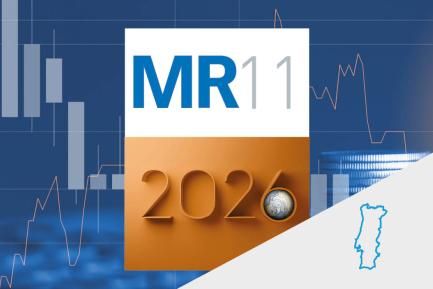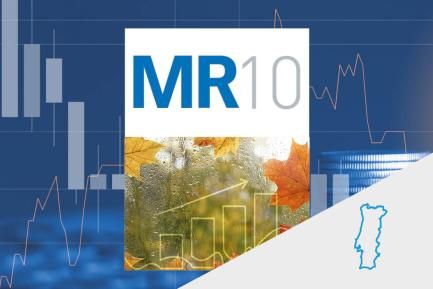The outlook for Portugal: an extended period of healthy growth
At the end of 2018, Portugal’s GDP has already returned to the levels of 2008,1 recovering the ground lost following the international financial crisis 10 years ago and the sovereign debt crisis in the euro area. Let’s not forget where we have come from: in a scenario of risk aversion that made it difficult to obtain funding in the market, it was necessary to resort to an external financial assistance programme which lasted between 2011 and 2014,2 and which forced the correction of existing imbalances. This setting, in turn, led to a cumulative drop in GDP of 6.0%.3 In 2014, the economy embarked on a period of recovery with increasingly strong rates of expansion, culminating with a growth of 2.8% in 2017. The increase in competitiveness has been one of the major drivers of the recovery and has resulted in exports providing a greater portion of the country’s GDP, rising from 34% in 2011 to 47% in 2017. In 2018, growth has remained strong, despite suffering a slight slowdown. This reflects the disappearance of external support factors, which we will analyse below, and the economy’s entry into a more mature phase of the cycle. How has the economy behaved recently and, above all, what can be expected in 2019-2020?
The latest data indicate that the slowdown is the result of two factors, namely a negative contribution from external demand and a slowdown in investment. Nevertheless, the economic outlook remains hopeful on the whole.
The negative impact of external demand is the result of an acceleration in the growth of imports, especially of investment goods, but also of consumer goods including durable goods and cars. Some of these factors are clearly temporary, such as the acceleration in vehicle imports in Q3 2018: the expectation of fiscal adjustments (which did not finally materialise) that would increase the cost of purchasing cars starting in September led households to bring their purchases forward, but this effect is going to dissipate in the coming quarters. However, the acceleration of imports also has a more stable component: investment and household consumption4 will remain strong, which will continue to fuel imports. This and a lower growth in exports, affected by the slowdown in global demand and a reduction in tourism activity, will result in ongoing negative contributions from external demand.
In this regard, the tourism sector, which has been the main driver of the correction in the external imbalance in recent years, now has less margin for growth. A moderate deceleration in the contribution of tourism activity to growth – the most reasonable scenario – would have an estimated impact on GDP growth of –0.2 pps (compared to this sector’s contribution in 2015). A stagnation of the sector would deduct 0.6 pps from growth.
However, even if exports lose some momentum,5 they will continue to be the main driver of growth for the economy, since they benefit from the improvement in the economy’s competitiveness and the greater role of the tradeable goods and services sector.
Investment, on the other hand, is the only component that will remain below pre-crisis levels at the end of the year, although it will remain buoyant. Various factors suggest that this component will continue to grow at around 5%, a lower rate than in 2017, but still noteworthy. In particular, the continuity of accommodative financial conditions could boost investment decisions in a context in which production capacity is already near its maximum levels.
In short, domestic demand will continue to make a substantial contribution to growth, above all thanks to the buoyancy of private consumption, which will continue to be supported by the strength of the labour market. Indeed, employment grew by 2.1% in Q3 2018 and the outlook for the coming quarters remains positive. Nevertheless, consumption could prove to be a little less buoyant than in 2017 and 2018, to the extent that the lower savings rate – which stands at 4.4% of gross disposable income (an all-time low) – will limit households’ ability to sustain an increase in their levels of expenditure over the coming years.
The factors that determine growth patterns
The recovery of the economy between 2014 and 2016, following the implementation of the financial assistance programme, would have been slower without the presence of a series of tailwinds that favoured growth. Primarily, these include the trend in the price of oil – between June 2014 and January 2015 it fell from 112 dollars per barrel to 50 dollars –, the decline in interest rates as a result of the ECB’s accommodative monetary policies, and the depreciation of the euro against the dollar – falling by 22% between March 2014 and April 2015. These factors were particularly present between 2014 and 2016. However, at the current juncture, many of these tailwinds have faded or have even changed direction to become headwinds. The most obvious examples include the oil price and the exchange rate: the oil price went from 48 dollars in June 2017 to approximately 80 dollars in October 2018, while the euro has appreciated 9% against the US dollar since the beginning of 2017.
In light of this inversion of the tailwinds, we estimated the impact that the aforementioned three factors (oil, interest rates and exchange rate), together with fiscal policy, will have on the expected GDP growth over the period 2018-2020.
As can be seen in the chart, oil prices and the exchange rate are having a substantial negative impact on growth in 2018 and would explain much of the current slowdown in the economy. All in all, the negative effect will not persist in 2019, since the recent depreciation of the euro and the expectation of a moderation in the oil price mean that most of the effect is concentrated in 2018.
The positive impact of the low interest rates, on the other hand, has vanished over the course of 2018, and it will become negative in 2019 when the ECB begins to normalise its monetary policy. These negative effects are clearly being offset by fiscal policy, which between 2018 and 2020 will be relatively expansionary, thus supporting growth.
In short, the negative net impact of the four factors analysed in our simple quantitative exercise will not exceed –0.25 pps of GDP in 2018, it will be practically nil in 2019 (although it could reach –0.2 pps if tourism were to decelerate), and it could reach –0.15 pps in 2020 due to the expectation of a gradual strengthening of the euro and the normalisation of monetary policy. By comparison, these factors had a positive contribution to growth of 1.6 and 0.6 pps in 2015 and 2016, respectively. These estimates therefore reinforce the prospect that growth could be somewhat more moderate over the next few years. All in all, the reduced support from temporary factors will not have an excessively onerous impact on growth, to the extent that the Portuguese economy will take advantage of some of the advances achieved at the structural level (for example, the reduction in public debt and the greater weight of the export sector). Therefore, the slowdown that we are witnessing must be understood as a sign of the economy’s entry into a more advanced phase of the cycle, which will materialise in growth rates at a healthy 2.0%.
Daniel Belo and Teresa Gil Pinheiro
BPI Research
1. In 2008, real GDP stood at 181.8 billion euros, and in 2018 it will be 183.8 billion euros.
2. The programme was aimed at achieving the structural correction of imbalances in the public finances and external accounts, the deleveraging of the economy and the implementation of reforms to remove the main structural obstacles to growth.
3. Equivalent to an average annual contraction of 1.5%.
4. The imported contribution of each unit of investment and consumption is 32% and 22%, respectively (Bank of Portugal, Economic Bulletin, December 2017).
5. The import content of exports is high (45%), so a rise in exports results in a higher volume of imports.





